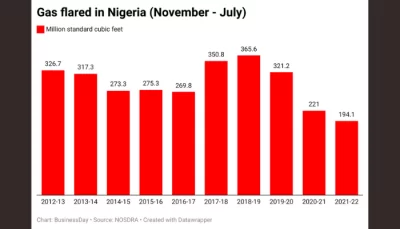Nigeria’s gas flares lowest since 2012 as use increases
Data from the Nigerian Oil Spill Monitor, an arm of the Nigerian Oil Spill Detection and Response Agency (NOSDRA) puts the volume of flares at 194.1 billion standard cubic feet (scf) of gas.
This development is helping Nigeria record positive momentum in keeping with its climate commitment. In November 2021, Nigeria joined other countries at the Conference of Parties (COP26) in Glasgow, Scotland, to meet its net-zero emissions target by 2060.
This is ten years later than the 2050 target set by the United Nation.
The total value of gas flared since Nigeria’s commitment in Glasgow is put at $679.3 million by NOSDRA, which analysts say indicate there is room for more gas use locally.
Kelechi Chidi-Ihuoma, Senior Investment Analyst, Meristem Securities Limited, said the lower gas flares volumes is a positive sign.
“Due to the campaign against the flaring of gas, companies are channeling it into a system to power plants.
“Most plants found in oil fields are usually powered by gas. Some companies use that gas to generate electricity which they transmit to neighbouring communities as their Environmental, Social, and Governance (ESG) project or corporate social responsibility,” she said.
According to Chidi-Ihuoma, companies that do not have any use for this gas, flare it because there is no infrastructure to channel it for utilisation.
However the development of news could upturn this reality. The bulk of gas produced in Nigeria is harnessed in the quest for gas. The recent slump in oil production has mean that few volumes of gas have been flared.
Curbing gas flaring would take capital expenditure (CAPEX), Janet Ogunkoya, senior research analyst, Tellimer Energy, said.
Read also: Nigerian manufacturers groan as gas supply constraints threaten operations
“It would take substantial CAPEX to have the necessary means to properly utilise gas.
“The gas flaring does not only show environmental impact but also shows economic losses because these gases can be utilised locally by power companies and other wholesale energy consumers or even exported.
“Thankfully, the likes of Seplat energy are seeing the economic benefits in capturing gas and processing it for commercial use, rather than flaring,” she said.
The research analyst said the cons – economic and environmental losses – are clear.
She said: “Communities in these areas get the first brunt of the environmental menace. But on a broader scale, the climate change impact is also quite grim.”
Oreoluwa Owolabi, corporate intelligence lead at GAS360, said Nigeria needs to invest in infrastructure to get the gas to a commercially viable point.
“This could be for export or pipelines across the country to generate electricity,” he said. “It necessitates a government-led effort, and the government has already taken some steps toward achieving a reduction in flaring by 2030.”
According to Owolabi, this can be used to accelerate Africa’s net-zero transition and there would be more funds available for gas projects, which can partially finance our infrastructure development.
“Accelerating the implementation of gas utilisation projects would increase the decline of gas flaring,” he said.
In its 2022 global gas flaring tracker report, the World Bank’s Global Gas Flaring Reduction Partnership (GGFR) ranked Nigeria as the seventh largest gas flaring country in the world in 2021.
According to satellite data, approximately 5.1 trillion cubic feet (tcf) – 143.4 billion cubic meters (bcm) – of gas was flared at upstream oil and gas facilities around the world in 2021, resulting in 382.4 million tonnes of carbon dioxide (CO2) equivalent emissions and a loss of $16.5 billion.
For Nigeria, data from the World Bank was broadly consistent with data from the Nigerian Oil Spill Monitor.
Timipre Sylva, Minister of State for Petroleum Resources, said in February 2021 that the government had committed to completely eliminating gas flaring by 2025, well ahead of the World Bank’s Zero Routine Flaring by 2030 target.


